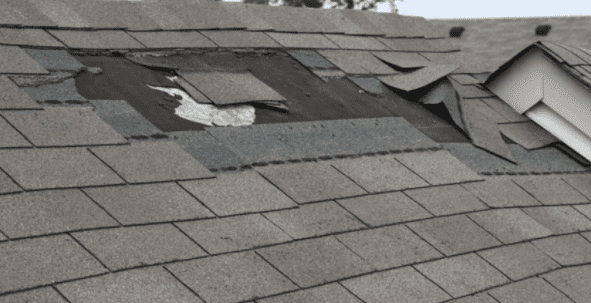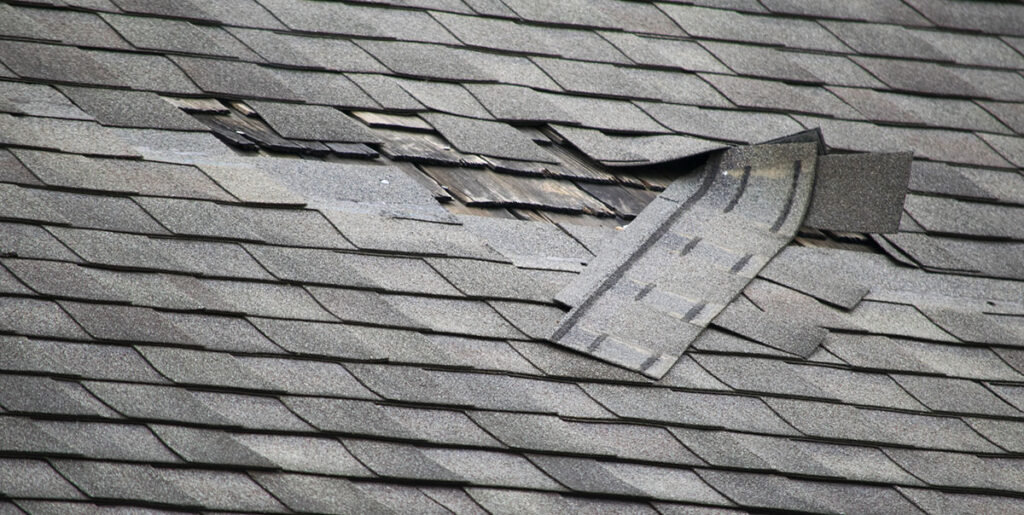In the realm of roof maintenance, one problem that homeowners often overlook is the impact of missing shingles on roof leakage. When a single shingle goes missing from your roof, it may seem inconsequential, but the consequences can be far-reaching. This article examines the potential consequences of missing shingles, delving into the factors that contribute to roof leakage and the importance of prompt repair. By understanding the true impact of missing shingles, you can take proactive steps to ensure the longevity and efficiency of your roof.
Impact of Missing Shingles on Roof Leakage

This image is property of www.billraganroofing.com.
Introduction
A roof is one of the most critical components of a building, protecting it from external elements such as rain, wind, and snow. Shingles, in particular, play a vital role in safeguarding the roof from water infiltration and ensuring its overall structural integrity. However, missing shingles can significantly compromise the effectiveness of a roof, leading to potential issues such as roof leakage and other related consequences. In this article, we will explore the various aspects of missing shingles, including their causes, potential consequences, detection methods, and the importance of timely repairs.
1. Understanding Shingles
– Composition and Purpose of Shingles
Shingles, typically made from materials like asphalt, wood, slate, or metal, serve as a protective outer layer for roofs. They are designed to shed water and protect the underlying structure from the elements. Each shingle overlaps with neighboring shingles, creating a barrier against water infiltration and ensuring proper drainage. This system is crucial in maintaining a leak-free roof.
– Importance of Proper Shingle Installation
Proper installation of shingles is essential to ensure their effectiveness in protecting the roof. The installation process involves careful placement, secure attachment, and correct alignment of the shingles. Incorrect installation can result in gaps, loose or improperly fastened shingles, and other vulnerabilities that increase the risk of shingle loss.
2. Common Causes of Missing Shingles
– Wind Damage
Wind is a common cause of missing shingles. Strong gusts can uplift and detach shingles if they are not properly secured. Higher wind speeds, especially during storms or hurricanes, pose a greater risk of shingle loss, particularly if the shingles are old or already weakened.
– Poor Installation
Improper installation techniques can also contribute to shingle loss. If shingles are not installed correctly, they may become more susceptible to damage from wind, weathering, or physical stressors. In such cases, even moderate wind can cause significant shingle displacement.
– Aging and Deterioration
Over time, shingles naturally deteriorate due to regular exposure to harsh weather conditions. Aging and wear can weaken the shingles, making them more prone to damage and loss. If shingles are not replaced in a timely manner as they age and become brittle, they are more likely to come off during storms or strong winds.
3. Potential Consequences of Missing Shingles
– Water Infiltration
One of the most significant consequences of missing shingles is water infiltration. When shingles are missing, the underlying roof structure becomes vulnerable to water penetration during rainfall or snowmelt. The absence of shingles creates gaps through which water can seep into the roof, leading to leaks and subsequent water damage within the building.
– Connection between Missing Shingles and Roof Leaks
Missing shingles directly contribute to roof leaks as they compromise the watertight barrier of the roof. Water can enter through the gaps left by the missing shingles, permeating the underlying layers of the roof and potentially causing damage to the insulation, decking, and other structural components. These leaks can result in costly repairs and may even necessitate the replacement of larger sections of the roof.
– Structural Damage
Apart from roof leakage, missing shingles can also lead to significant structural damage. As water infiltrates the roof, it can saturate the roofing materials and potentially weaken the supporting structure, including the rafters and trusses. If left unaddressed, this can compromise the structural integrity of the entire building, posing a serious safety risk.
– Mold and Mildew Growth
Excessive moisture from roof leaks caused by missing shingles creates an ideal environment for the growth of mold and mildew. These microbial organisms thrive in damp environments and can quickly spread throughout the affected area. Mold and mildew not only pose health risks to occupants but can also cause further damage to the roof, insulation, and other building materials, necessitating costly remediation efforts.
– Decreased Energy Efficiency
Missing shingles not only allow water to infiltrate but also enable air leakage, leading to decreased energy efficiency within the building. Gaps in the roof due to missing shingles can result in heat loss during colder months and heat gain during warmer months. This puts additional strain on heating and cooling systems, leading to higher energy consumption and increased utility costs.

This image is property of reggiereedroofing.com.
4. Detecting Missing Shingles
– Visual Inspection
Performing a visual inspection of the roof is an essential step in detecting missing shingles. From the ground or using a ladder, carefully examine the roof’s surface, paying close attention to any visible signs of shingle displacement, gaps, or areas where individual shingles may be absent.
– Indoor Signs of Roof Leakage
Another indicator of missing shingles and roof leakage is the presence of water stains or discoloration on the ceilings or walls inside the building. These visible signs may suggest that water is infiltrating the roof and leaking into the interior space, likely caused by missing or damaged shingles.
– Professional Roof Inspection
Engaging the services of a professional roofing contractor for a comprehensive roof inspection is highly recommended. Professionals have the expertise to identify missing shingles and assess the overall condition of the roof, including any underlying damage that may have occurred due to the missing shingles.
5. Immediate and Long-Term Solutions
– Temporary Measures
In the case of missing shingles, it is crucial to address the issue promptly to minimize further damage. Temporary measures can be taken to mitigate immediate risks. These can include the use of tarps or roof sealants to cover the exposed areas and prevent water infiltration until a more permanent solution is implemented.
– Permanent Solutions
For a lasting resolution, the permanently missing shingles must be replaced. Replacing the missing shingles involves carefully removing the damaged or loose shingles and installing new ones. Additionally, regular roof maintenance and repairs can help prevent future issues with missing shingles and strengthen the overall integrity of the roof.

This image is property of roofproplus.com.
6. Cost Considerations
– Potential Expenses of Ignoring Missing Shingles
Ignoring missing shingles can result in significant financial implications. Roof leaks caused by missing shingles can lead to extensive water damage within the building, necessitating costly repairs or even full-scale roof replacement. Additionally, the resultant mold growth and compromised energy efficiency can further escalate expenses related to remediation and increased utility bills.
– Repair and Replacement Costs
The cost of repairing or replacing missing shingles depends on various factors, such as the extent of the damage, the type of shingles, and the size of the roof. On average, repairs for missing shingles can range from a few hundred to a few thousand dollars, while full roof replacements can cost several thousand dollars or more. Investing in timely repairs is often more cost-effective in the long run, as it helps prevent more extensive damage and subsequent higher expenses.
7. Importance of Timely Roof Repairs
– Preventing Further Damage
Addressing missing shingles promptly is crucial to prevent further damage to the roof and the building’s interior. Timely repairs help minimize the risk of leaks, structural damage, mold growth, and other associated problems, ultimately protecting the occupants and preserving the value of the property.
– Extending Roof Lifespan
Regular maintenance and timely repairs, including addressing missing shingles, can significantly extend the lifespan of a roof. By ensuring that the roof remains structurally sound and the shingles are intact, the need for premature roof replacement is minimized, resulting in long-term cost savings.

This image is property of arnettconstructionandroofing.com.
8. DIY vs. Professional Assistance
– Advantages of Professional Roofing Services
While some individuals may be inclined to address missing shingles on their own, seeking professional roofing services offers several advantages. Professional roofers have the necessary skills, experience, and knowledge to accurately identify and address missing shingles and underlying issues. They also have access to specialized tools and materials, ensuring proper shingle installation and long-lasting repairs.
– Risks of DIY Roof Repairs
Attempting to repair missing shingles without the appropriate expertise can lead to further damage and potential safety hazards. Climbing on a roof without proper training or safety equipment can be risky, increasing the likelihood of accidents or injury. Additionally, without proper knowledge and understanding of roofing systems, DIY repairs may not effectively address the root cause of missing shingles or adequately prevent future issues.
9. Hiring a Roofing Contractor
– Qualifications and Experience
When considering hiring a roofing contractor, it is essential to ensure they possess the requisite qualifications and experience. Look for contractors who are licensed, insured, and certified by reputable organizations. Experienced contractors have a deeper understanding of roof systems and can provide expert advice and quality workmanship.
– Reputation and References
Checking a contractor’s reputation and references is crucial to ensure their credibility and reliability. Look for reviews and testimonials from previous clients, and ask for references from the contractor. This provides insight into the contractor’s professionalism, quality of work, and adherence to timelines and budgets.
– Cost Estimates and Contracts
Obtaining cost estimates from multiple roofing contractors allows for effective comparison and informed decision-making. Discuss the scope of work, materials, and timelines with the contractor, and ensure that all details are documented in a written contract. Having a clear agreement in place protects both parties and minimizes the risk of misunderstandings or disputes.

This image is property of i0.wp.com.
10. Conclusion
Missing shingles can have a significant impact on a roof’s integrity, leading to roof leakage and various other consequences. Understanding the causes and potential consequences of missing shingles is essential for prompt detection and necessary repairs. By addressing missing shingles in a timely manner, either through temporary measures or permanent solutions, further damage can be prevented, and the lifespan of the roof can be extended. Seeking professional assistance from reputable roofing contractors ensures the proper repair and maintenance of missing shingles, protecting the building and its occupants. Remember, taking proactive measures to address missing shingles is a wise investment in safeguarding your property and avoiding long-term costs and complications.
